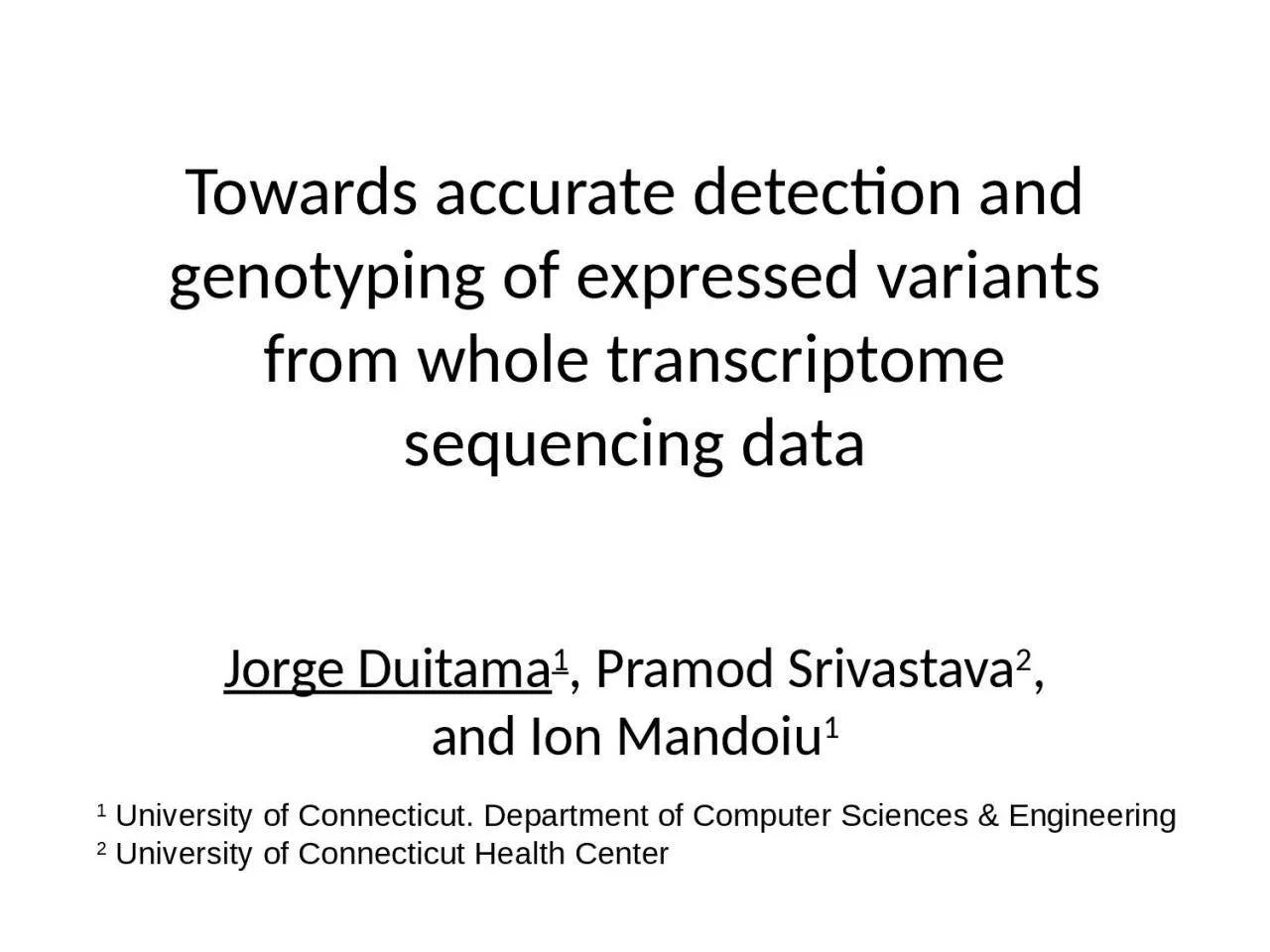

transcriptome sequencing data Jorge Duitama 1 Pramod Srivastava 2 and Ion Mandoiu 1 1 University of Connecticut Department of Computer Sciences amp Engineering 2 University of Connecticut Health Center ID: 926672
Download Presentation The PPT/PDF document "Towards accurate detection and genotypin..." is the property of its rightful owner. Permission is granted to download and print the materials on this web site for personal, non-commercial use only, and to display it on your personal computer provided you do not modify the materials and that you retain all copyright notices contained in the materials. By downloading content from our website, you accept the terms of this agreement.
Slide1
Towards accurate detection and genotyping of expressed variants from whole transcriptome sequencing data
Jorge Duitama1, Pramod Srivastava2, and Ion Mandoiu1
1
University of Connecticut. Department of Computer Sciences & Engineering
2
University of Connecticut Health Center
Slide2IntroductionRNA-Seq is the method of choice for studying functional effects of genetic variability
RNA-Seq poses new computational challenges compared to genome sequencingIn this paper we present: a strategy to map transcriptome reads using both the genome reference sequence and the CCDS database.a novel Bayesian model for SNV discovery and genotyping based on quality scores
Slide3Read Mapping
Reference genome
sequence
>ref|NT_082868.6|Mm19_82865_37:1-3688105 Mus musculus chromosome 19 genomic contig, strain C57BL/6J
GATCATACTCCTCATGCTGGACATTCTGGTTCCTAGTATATCTGGAGAGTTAAGATGGGGAATTATGTCA
ACTTTCCCTCTTCCTATGCCAGTTATGCATAATGCACAAATATTTCCACGCTTTTTCACTACAGATAAAG
AACTGGGACTTGCTTATTTACCTTTAGATGAACAGATTCAGGCTCTGCAAGAAAATAGAATTTTCTTCAT
ACAGGGAAGCCTGTGCTTTGTACTAATTTCTTCATTACAAGATAAGAGTCAATGCATATCCTTGTATAAT
@HWI-EAS299_2:2:1:1536:631
GGGATGTCAGGATTCACAATGACAGTGCTGGATGAG
+HWI-EAS299_2:2:1:1536:631
::::::::::::::::::::::::::::::222220
@HWI-EAS299_2:2:1:771:94
ATTACACCACCTTCAGCCCAGGTGGTTGGAGTACTC
+HWI-EAS299_2:2:1:771:94
:::::::::::::::::::::::::::2::222220
Read sequences &
quality scores
SNP calling
1 4764558 G T 2 1
1 4767621 C A 2 1
1 4767623 T A 2 1
1 4767633 T A 2 1
1 4767643 A C 4 2
1 4767656 T C 7 1
SNP Calling from Genomic DNA Reads
Slide4Mapping mRNA Reads
http://en.wikipedia.org/wiki/File:RNA-Seq-alignment.png
Slide5C.
Trapnell, L. Pachter, and S.L. Salzberg. TopHat: discovering splice junctions with RNA-Seq. Bioinformatics, 25(9):1105–1111, 2009.
Slide6Mapping and Merging Strategy
Tumor mRNA readsCCDSMapping
Genome Mapping
Read
Merging
CCDS mapped reads
Genome mapped reads
Mapped reads
Slide7Read Merging
GenomeCCDSAgree?Hard MergeSoft MergeUniqueUniqueYesKeepKeep
Unique
Unique
No
Throw
Throw
Unique
Multiple
No
Throw
Keep
Unique
Not Mapped
No
Keep
Keep
MultipleUnique
NoThrow
KeepMultipleMultiple
No
ThrowThrow
Multiple
Not MappedNoThrow
ThrowNot mappedUniqueNoKeepKeepNot mapped
MultipleNoThrowThrowNot mappedNot MappedYesThrow
Throw
Slide8SNV Detection and Genotyping
AACGCGGCCAGCCGGCTTCTGTCGGCCAGCAGCCAGGAATCTGGAAACAATGGCTACAGCGTGCAACGCGGCCAGCCGGCTTCTGTCGGCCAGCCGGCAG CGCGGCCAGCCGGCTTCTGTCGGCCAGCAGCCCGGA GCGGCCAGCCGGCTTCTGTCGGCCAGCCGGCAGGGA GCCAGCCGGCTTCTGTCGGCCAGCAGCCAGGAATCT
GCCGGCTTCTGTCGGCCAGCAGCCAGGAATCTGGAA
CTTCTGTCGGCCAGCCG
G
CAGGAATCTGGAAACAAT
CGGCCAGCAGCCAGGAATCTGGAAACAATGGCTACA
CCAGCAGCCAGGAATCTGGAAACAATGGCTACAGCG
CAAGCAGCCAGGAATCTGGAAACAATGGCTACAGCG
GCAGCCAGGAATCTGGAAACAATGGCTACAGCGTGC
Reference
Locus
i
R
i
r(
i
) : Base call of read r at locus
i
ε
r(
i
)
: Probability of error reading base call r(
i)Gi : Genotype at locus i
Slide9SNV Detection and GenotypingUse Bayes
rule to calculate posterior probabilities and pick the genotype with the largest one
Slide10Current ModelsMaq
:Keep just the alleles with the two largest countsPr (Ri | Gi=
H
i
H
i
)
is
the
probability
of observing k alleles r(i) different
than Hi
Pr (Ri | Gi
=HiH’i)
is approximated as a binomial
with p=0.5SOAPsnpPr (r
i | Gi=H
iH’i) is
the average of Pr(ri
|Hi) and Pr(ri|G
i=H’i)A
rank test on the quality scores of the allele
calls is used to confirm heterozygocity
Slide11SNV Detection and GenotypingCalculate conditional probabilities by multiplying contributions of individual reads
Slide12Accuracy Assessment of Variants Detection113 million Illumina
mRNA reads generated from blood cell tissue of Hapmap individual NA12878 (NCBI SRA database accession numbers SRX000565 and SRX000566)We tested genotype calling using as gold standard 3.4 million SNPs with known genotypes for NA12878 available in the database of the Hapmap projectTrue positive: called variant for which Hapmap genotype coincidesFalse positive: called variant for which Hapmap genotype does not coincide
Slide13Comparison of Mapping Strategies
Slide14Comparison of Variant Calling Strategies
Slide15Data Filtering
Slide16Data FilteringAllow just x reads per start locus to eliminate PCR amplification artifactsChepelev
et. al. algorithm:For each locus groups starting reads with 0, 1 and 2 mismatchesChoose at random one read of each group
Slide17Comparison of Data Filtering Strategies
Slide18Accuracy per RPKM bins
Slide19ConclusionsWe presented a new strategy to map mRNA reads using both the reference genome and the CCDS database and a new bayesian
model for SNV detection and genotypingExperiments on publicly available datasets show that our methods outperform widely used SNV detection methodsFuture Work:Improve genotype calling by adapting our model to differential allelic expressionUse our methods on RNA-Seq data from cancer tumor data
Slide20Acknowledgments
Brent Graveley and Duan Fei (UCHC)NSF awards IIS-0546457, IIS-0916948, and DBI-0543365UCONN Research Foundation UCIG grant